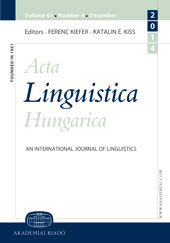The most important prosodic patterns of Hungarian
The most important prosodic patterns of Hungarian
Author(s): Gábor OlaszySubject(s): Theoretical Linguistics, Finno-Ugrian studies
Published by: Akadémiai Kiadó
Keywords: prosody; speech synthesis; melody of sentence types; stylized intonation patterns; perception experiments;
Summary/Abstract: Abstract Prosody is a general term for the following features in speech: pitch and intonation, stress, articulation rate, sound intensity and time structure (rhythm and pauses). During verbal communication various prosodic forms contribute to the expression of the content of the message (the information carried by the text, emotional expression, to imitate a situation etc.). So, prosody can be represented as a multivariable function in which the number of variables is rather high. Therefore it is difficult to describe the complex process for all situations, meanings, and emotions. In this paper we try to give a phonetic level characterization of pitch and intonation structure and also the function of intensity in time of the main Hungarian sentence types (using a unified description). The manner of description is new concerning Hungarian. It is based on a unified relative scale in which not physical values but relative distances in pitch values and intensity are used to characterize the melody forms and the intensity levels. This description allows for the representation of these two prosodic elements independently of the personal features (mean F0 value, the range of the F0 of the speaker, etc.). The representation makes it possible to express the crossfunctions among the melody forms of different expressions. This means that complete prosodic patterns can be predicted for any text without an acoustic analysis.
Journal: Acta Linguistica Hungarica (Since 2017 Acta Linguistica Academica)
- Issue Year: 49/2002
- Issue No: 3-4
- Page Range: 277-306
- Page Count: 30
- Language: English

